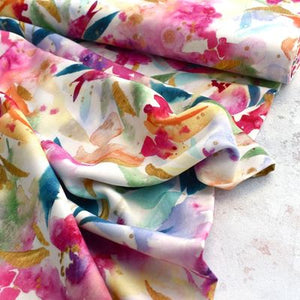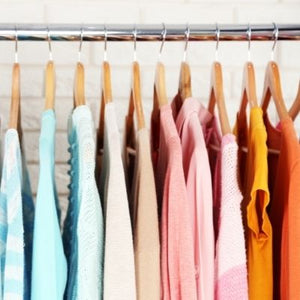Okay, you’ve got the sewing machine, fabric, needles, and thread. All set, right?? Well…there are definitely a few other things you’ll need in your toolkit as you progress on your sewing journey. Much like all the fantastic fabric options available, there are TONS of sewing-related tools out there. But what do you really need? And what will help make your sewing life easier? Let us help take out some of the guesswork with our top picks for must-have sewing tools, along with a few other suggestions for next-level tools of the trade!
1. Scissors
Scissors are going to be the most utilized tools in your sewing arsenal aside from your machine itself. At a minimum, you need two pairs—one for cutting fabric and another for cutting out paper patterns. Though it seems like these two could serve the same purpose, you will quickly find that they are very different. If you use your fabric scissors to cut paper or other material (other than fabric), they quickly become dull and start to give you less precise results.
Your best bet is to invest in a quality pair of fabric shears and have them sharpened frequently. And then have a more economical pair for the scissors you’ll use to cut paper. It is also helpful to label each pair so that you, and others, don’t reach for the wrong pair!
Level up! Other good scissor options to have in your arsenal include pinking shears to trim fraying edges, thread snips for clipping pattern notches and removing odd threads, and duckbill or curved scissors for trimming seam allowances.

2. Rotary Cutter & Mat
A 45mm rotary cutter is an incredibly useful tool with a sharp rotating blade attached to a handle for cutting pieces of fabric by following along the shape of pattern pieces. These blades should always be used with a self-healing mat to protect the cutting surface and the blade itself. A mat that measures 24” x 36” is a great choice for most home sewers. You can also line up multiple mats or order a custom-sized mat to better fit your cutting space/table.
Level up! A 28mm rotary cutter is a great addition for precision cutting on smaller corners or more delicate fabrics.
3. Pattern Weights
Pattern weights are a must when trying to keep your paper patterns in place while tracing or cutting. There are various pattern weights available from the industrial to the adorable, but lots of sewists use heavy-duty metal washers or even hexagon tiles from their local hardware stores. You can also use whatever you can find around the house—coasters, canned food, and coffee mugs are all great options!

4. Pins & Pincushions
The truth is, without pins, all of your planned sewing projects would fall apart -- literally! Which pins you should use for sewing your garments is determined by the fabric you are working with. For most projects, standard dressmaking pins will work. These come with metal, plastic, or glass heads and depending on your preference. For more delicate fabrics such as lace or silk, it is best to use extra-fine or silk pins, which have an extra sharp point and a thinner profile to help to avoid making permanent holes. Also, be sure to have a fabric or magnetic pincushion to safely keep all of these tiny sharp objects in one place...no one wants to “find” dropped pins with their feet!
Level up! Wonder Clips and Wonder tape are two more useful tools for holding fabric together during the garment-making process. Wonder clips are great for delicate fabrics that pins could permanently damage or extra thick layers that pins have difficulty getting through. And Wonder Tape isn’t called that by accident! It’s fantastic for holding zippers, pockets, and hems in place while sewing and then washes away in the laundry!
5. Flexible Measuring Tape & Plastic Ruler
Having reliable, quality measuring tools in your sewing arsenal is a must! You will find yourself using these multiple times with each garment you construct, from taking your own measurements to measuring folds or hem amounts. A flexible measuring tape is essential for taking the body measurements of whomever you are constructing garments for. To ensure accurate measurements, be sure to have one made of sturdy material, like vinyl, and check the gauge of your tape from time to time against a metal tape measure.
A clear plastic or quilter's ruler is also useful and will help when making precise marks or adjustments on your pattern pieces. It’s best to get both of these tools with inches and centimeters since you will likely come across both standards while sewing.
Level up! A seam gauge and a hot ruler (or iron safe ruler) are two tools that will make measuring and ironing smaller increments on areas like sleeves and hems both easier and more exact.

6. Marking Tools
There is a huge variety of marking tools to choose from, which can be both intimidating and helpful once you find which works best for you. Since these are tools with minimal investment but are highly subject to personal preference, your best bet is to try a couple of different styles, see how you like them, and go from there.
Some variations include the familiar triangular-shaped Tailor's chalk, refillable Chaco liners, chalk pencils, and water-soluble or iron-off markers. Each of these comes in a variety of colors and has its benefits and drawbacks. Tailor’s chalk is excellent for heavier fabrics, but the lines can often fade quickly or appear faint from the start, while Chaco liners never need sharpening and give a precise line but are the most expensive of the bunch. Water-soluble and iron-off markers come in various colors and create thin, accurate marks on fabric, but there is an ongoing debate about the reliability of these marks truly washing out or fading completely.
7. Interfacing
Interfacing comes in different types meant for either knit or woven fabrics and is fused or sewn into garments in areas that may need more structure or support than the fabric alone can provide. Typical uses include button plackets, collars, pockets, and anywhere where hardware is attached. Fusible interfacing is the most common as it can be easily attached to fabric through pressing and/or steaming.
The three main weights are light-weight, mid-weight, and heavy-weight, and it is best to match the weight and drape of the interfacing as closely as possible to the fabric you are sewing. Also, always check the manufacturer's recommended pressing instructions and consider preshrinking your interfacing before using it.
Level Up! Look into interfacings of different colors to better match the fabric you’re working with, along with specialty interfacings that may be recommended in your pattern directions. There are also various interfacing tapes, perfect for hems and reinforcing seams.

8. Pressing Tools
A steam iron is going to be the single best tool for turning homemade makes into garments that have people asking you, “Where did you buy that?” Professional-looking crisp seams, sharp darts, and flat hems are created with quality pressing techniques and tools! However, it is crucial that your temperature and steam settings are correct for the fabric you are working with to avoid unintended press marks, unsightly shine, or impressions coming through.
A pressing cloth is also helpful and gives an additional layer of protection between the fabric and iron, especially on delicate fabrics. Of course, you’ll also need an ironing board or heat-resistant pressing surface. Do a little exploring to find the best option that suits your sewing space and budget!
Level Up! A tailor’s ham is helpful for pressing curved seams, while a wood clapper creates seams that lay beautifully flat and crisp.
9. Seam Ripper
Humbling as it may be, your seam ripper will likely be one of your most-used tools, especially for those new to sewing. Everyone sews the wrong pieces together, topstitches in the wrong place, or needs to rip out basting stitches from time to time. You'll also find the seam ripper makes more appearances the more tired you are...just saying!
Though the traditional U-shaped seam ripper is the most popular, there are also razor and scalpel types, all of which come in various sizes and shapes. Try a couple of different ones and see what works best for you!

10. Specialty Tools
There is an exciting (and enormous!!) number of specialty sewing tools out there to explore! A few favorites to take your sewing to the next level include a pattern notcher and French curve ruler for making adjustments and markings, a bodkin for threading elastic and drawstrings, and a point turner, buttonhole cutter, and sewing awl for finishing details.
----
Please Note: If you’re a brand new sewist, there’s no need to run out and buy the best version of each of these tools. Instead, we recommend gradually adding them as the need arises and your budget permits.







Excellent article. I agree with all of your suggestions. I have different sizes of pins depending on the fabric I am sewing and the use I will make of the item. My biggest problem is deciding what size pin to use on silk as, depending on the manufacturer, different sizes may be recommended.
Leave a comment